Investigation of Pumped Storage Hydropower Power-Off Transient Process Using 3D Numerical Simulation Based on SP-VOF Hybrid Model
Abstract
:1. Introduction
2. Numerical Methods
2.1. Governing Equations
2.2. Turbulence Model
2.3. 3D Hybrid Simulation Method
2.4. Algorithm of Power-off Transient Simulation
3. Case Study
3.1. Geometry Model and Initial Parameters
3.2. Grid Technology
3.3. Equations Discretization and Boundary Condition
3.4. Data Monitoring and Processing
4. Results and Discussion
4.1. Test Results of Grid and Time Dependency
4.2. The Varying Law of Dynamic Characteristics Parameters
4.3. Comparisons between Numerical and Experimental Results
4.4. Transient Flow Fields
5. Conclusions
Acknowledgments
Author Contributions
Conflicts of Interest
Nomenclature
| D | Runner outlet diameter | m |
| F | External body force | N |
| Fz | Axial force | N |
| Fr | Radial force | N |
| g | Gravitational body force | m/s2 |
| H0 | Initial pumping lift | m |
| I | Unit tensor | - |
| J | Total unit moment of inertia | kg·m2 |
| M | Resultant torque of the rotational system | N |
| M0 | Initial torque | N |
| Mass transfer from water to air | kg | |
| Mass transfer from air to water | kg | |
| n | Runner rotating speed | r/min |
| n0 | Initial runner rotating speed | r/min |
| ns | Specific speed of pump-turbine unit | m·kW |
| p | Static pressure | MPa |
| P0 | Initial input power | kW |
| Psc | Static pressure of spiral casing inlet | MPa |
| Q | Unit flow rate | m3/s |
| Q0 | Initial unit flow rate | m3/s |
| Qst | Surge tank flow rate | m3/s |
| Source term | kg/(m3·s) | |
| t | Time | s |
| u | Velocity | m/s |
| Runner outlet rotating speed | rad/s | |
| Volume fraction of water in a cell | - | |
| Volume fraction of air in a cell | - | |
| Relaxation factor | - | |
| ρ | Density of fluid | kg/m3 |
| μ | Molecular viscosity | Pa·s |
| γ | Initial guide vane opening angle | ° |
| Stress tensor | - | |
| Time step size | s | |
| Changing amount of guide vane opening | ° |
Abbreviations
| 1D | One dimensional |
| 3D | Three dimensional |
| CFD | Computational fluid dynamics |
| MOC | Method of characteristics |
| PISO | Pressure implicit with splitting of operators |
| PSH | Pumped storage hydropower |
| SIMPLEC | Semi-implicit method for pressure linked equations-consistent |
| SP | Single-phase |
| UDF | User defined function |
| VOF | Volume of fluid |
References
- Benjamin, K.S. The intermittency of wind, solar and renewable electricity generators: Technical barrier or rhetorical excuse? Util. Policy 2009, 17, 288–296. [Google Scholar]
- Cheng, C.; Cheng, X.; Shen, J.; Wu, X. Short-term peak shaving operation for multiple power grids with pumped storage power plants. Int. J. Electr. Power Energy Syst. 2015, 67, 570–581. [Google Scholar] [CrossRef]
- Pérez-Díaz, J.I.; Chazarra, M.; García-González, J.; Cavazzini, G.; Stoppato, A. Trends and challenges in the operation of pumped-storage hydropower plants. Renew. Sustain. Energy Rev. 2015, 44, 767–784. [Google Scholar] [CrossRef]
- Zeng, M.; Zhang, K.; Liu, D. Overall review of pumped-hydro energy storage in China: Status quo, operation mechanism and policy barriers. Renew. Sustain. Energy Rev. 2013, 17, 35–43. [Google Scholar]
- Widmer, C.; Staubli, T.; Ledergerber, N. Unstable characteristics and rotating stall in turbine brake operation of pump-turbines. J. Fluids Eng. 2011, 133, 041101. [Google Scholar] [CrossRef]
- Hasmatuchi, V.; Farhat, M.; Roth, S.; Botero, F.; Avellan, F. Experimental evidence of rotating stall in a pump-turbine at off-design conditions in generating mode. J. Fluids Eng. 2011, 133, 051104. [Google Scholar] [CrossRef]
- Hasmatuchi, V. Hydrodynamics of a Pump-Turbine Operating at Off-Design Conditions in Generating Mode. Ph.D. Thesis, École Polytechnique Fédérale de Lausanne (EPFL), Lausanne, Switzerland, 2012. [Google Scholar]
- Liu, J.; Liu, S.; Sun, Y.; Wu, Y.; Wang, L. Three dimensional flow simulation of load rejection of a prototype pump-turbine. Eng. Comput. 2013, 29, 417–426. [Google Scholar]
- Thanapandi, P.; Prasad, R. Centrifugal pump transient characteristics and analysis using the method of characteristics. Int. J. Mech. Sci. 1995, 37, 77–89. [Google Scholar] [CrossRef]
- Afshar, M.H.; Rohani, M.; Taheri, R. Simulation of transient flow in pipe line systems due to load rejection and load acceptance by hydroelectric power plants. Int. J. Mech. Sci. 2010, 52, 103–115. [Google Scholar] [CrossRef]
- Wan, W.; Huang, W. Investigation on complete characteristics and hydraulic transient of centrifugal pump. J. Mech. Sci. Technol. 2011, 25, 2583–2590. [Google Scholar] [CrossRef]
- Zhang, J.; Lu, W.; Fan, B.; Hu, J. The influence of layout of water conveyance system on the hydraulic transients of pump-turbines load successive rejection in pumped storage station. J. Hydroelectr. Eng. 2008, 27, 158–162. (In Chinese) [Google Scholar]
- Zhou, J.; Xu, Y.; Zheng, Y.; Zhang, Y. Optimization of guide vane closing schemes of pumped storage hydro unit an enhanced multi-objective gravitational search algorithm. Energies 2017, 10, 911. [Google Scholar] [CrossRef]
- Li, Z.; Bi, H.; Karney, B.; Wang, Z.; Yao, Z. Three-dimensional transient simulation of a prototype pump-turbine during normal turbine shutdown. J. Hydraul. Res. 2017, 55, 520–537. [Google Scholar]
- Gajic, A. Steady and Transient Regimes in Hydropower Plants; IOP Conference Series: Materials Science and Engineering; IOP Publishing: Bristol, UK, 2013; Volume 52. [Google Scholar]
- Yang, W.; Wu, Y.; Liu, S. An optimization method on runner blades in bulb turbine based on CFD analysis. Sci. China Technol. Sci. 2011, 54, 338–344. [Google Scholar] [CrossRef]
- Litfin, O.; Mohr, C.; Haddad, K.; Epple, P.; Semel, M.; Becker, K.; Klein, H.; Delgado, A. CFD computation, analysis and design of a two-bladed wastewater pump. In Proceedings of the ASME 2011 International Mechanical Engineering Congress & Exposition, Denver, CO, USA, 11–17 November 2011; p. 64195. [Google Scholar]
- Sedlar, M.; Sputa, O.; Komarek, M. CFD analysis of cavitation phenomena in mixed-flow pump. Int. J. Fluid Mach. Syst. 2012, 5, 18–29. [Google Scholar] [CrossRef]
- Xia, L.; Cheng, Y.; Zhou, D. 3-D simulation of transient flow patterns in a corridor-shaped air-cushion surge chamber based on computational fluid dynamics. J. Hydrodyn. Ser. B 2013, 25, 249–257. [Google Scholar] [CrossRef]
- Nicolle, J.; Morissette, J.F.; Giroux, A.M. Transient CFD Simulation of a Francis Turbine Startup; IOP Conference Series: Earth and Environmental Science; IOP Publishing: Bristol, UK, 2012; Volume 15. [Google Scholar]
- Zhou, D.; Wu, Y.; Liu, S. Three-dimensional CFD simulation of the runaway transients of a propeller turbine model. J. Hydraul. Eng. 2010, 41, 233–238. [Google Scholar]
- Cherny, S.; Chirkov, D.; Bannikov, D.; Lapin, V.; Skorospelov, V.; Eshkumova, I.; Avdushenko, A. 3D Numerical Simulation of Transient Processes in Hydraulic Turbines; IOP Conference Series: Earth and Environmental Science; IOP Publishing: Bristol, UK, 2010; Volume 12. [Google Scholar]
- Huang, W.; Fan, H.; Chen, N. Transient Simulation of Hydropower Station with Consideration of Three-Dimensional Unsteady Flow in Turbine; IOP Conference Series: Earth and Environmental Science; IOP Publishing: Bristol, UK, 2012; Volume 15. [Google Scholar]
- Yang, S.; Chen, X.; Wu, D.; Yan, P. Dynamic analysis of the pump system based on MOC–CFD coupled method. Ann. Nucl. Energy 2015, 78, 60–69. [Google Scholar] [CrossRef]
- Zhang, X.; Cheng, Y.; Yang, J.; Xia, L.; Lai, X. Simulation of the load rejection transient process of a Francis turbine by using a 1-D-3-D coupling approach. J. Hydrodyn. Ser. B 2014, 26, 715–724. [Google Scholar] [CrossRef]
- Liu, J.; Liu, S.; Sun, Y.; Jiao, L.; Wu, Y.; Wang, L. Three-dimensional flow simulation of transient power interruption process of a prototype pump-turbine at pump mode. J. Mech. Sci. Technol. 2013, 27, 1305–1312. [Google Scholar] [CrossRef]
- Li, Y.; Song, G.; Yan, Y. Transient hydrodynamic analysis of the transition process of bulb hydraulic turbine. Adv. Eng. Softw. 2015, 90, 152–158. [Google Scholar] [CrossRef]
- Mao, X.; Monte, A.D.; Benini, E.; Zheng, Y. Numerical study on the internal flow field of a reversible turbine during continuous guide vane closing. Energies 2017, 10, 988. [Google Scholar] [CrossRef]
- Luo, X.; Li, W.; Feng, J.; Zhu, G. Simulation of runaway transient characteristics of tubular turbine based on CFX secondary development. Trans. Chin. Soc. Agric. Eng. 2017, 33, 97–103. [Google Scholar]
- Zhou, L.; Liu, D.; Ou, C. Simulation of flow transients in a water filling pipe containing entrapped air pocket with VOF model. Eng. Appl. Comput. Fluid Mech. 2011, 5, 127–140. [Google Scholar] [CrossRef]
- Guo, L.; Liu, Z.; Geng, J.; Li, D.; Du, G. Numerical study of flow fluctuation attenuation performance of a surge tank. J. Hydrodyn. Ser. B 2013, 25, 938–943. [Google Scholar] [CrossRef]
- Hirt, C.W.; Nichols, B.D. Volume of fluid (VOF) method for the dynamics of free boundaries. J. Comput. Phys. 1981, 39, 201–225. [Google Scholar] [CrossRef]
- Shih, T.-H.; Liou, W.W.; Shabbir, A.; Yang, Z.; Zhu, J. A New k-ɛ Eddy-Viscosity Model for High Reynolds Number Turbulent Flows—Model Development and Validation. Comput. Fluids. 1995, 24, 227–238. [Google Scholar] [CrossRef]
- Murayama, M.; Nakahashi, K.; Matsushima, K. Unstructured Dynamic Mesh for Large Movement and Deformation. In Proceedings of the 40th Aerospace Sciences Meeting and Exhibit, Reno, NV, USA, 14–17 January 2002; p. AIAA-2002-0122. [Google Scholar]
- Zheng, J.; Liu, W.; Fu, Z.; Shi, Q. The Hydraulic Design of Pump Turbine for Xianyou Pumped Storage Power Station; IOP Conference Series: Earth and Environmental Science; IOP Publishing: Bristol, UK, 2012; Volume 15. [Google Scholar]
- Meniconi, S.; Brunone, B.; Ferrante, M. In-line pipe device checking by short-period analysis of transient tests. J. Hydraul. Eng. 2011, 137, 713–722. [Google Scholar] [CrossRef]
- Stevanovic, V.; Studovic, M.; Bratic, A. Simulation and analysis of a main steam line transient with isolation valves closure and subsequent pipe break. Int. J. Numer. Methods Heat Fluid Flow 1994, 4, 387–398. [Google Scholar] [CrossRef]

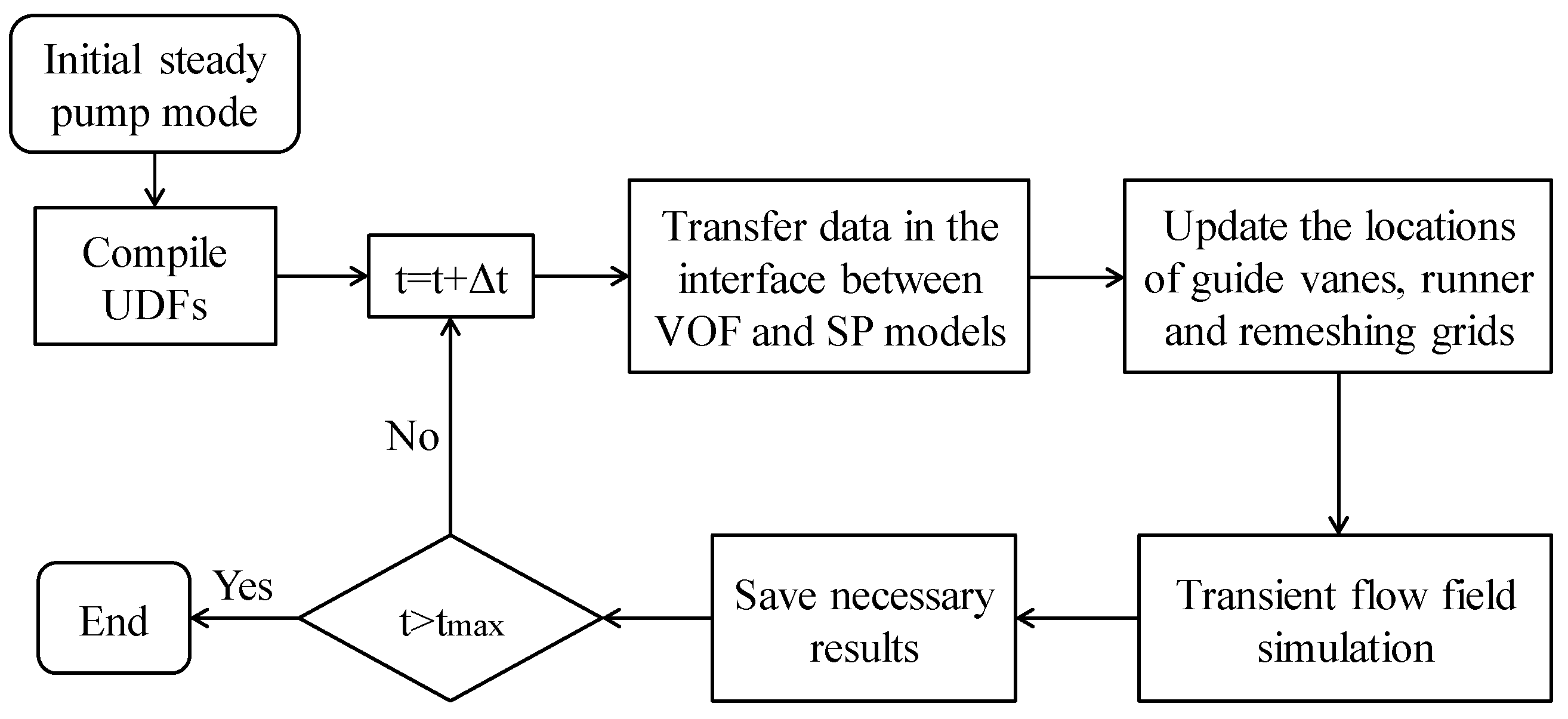
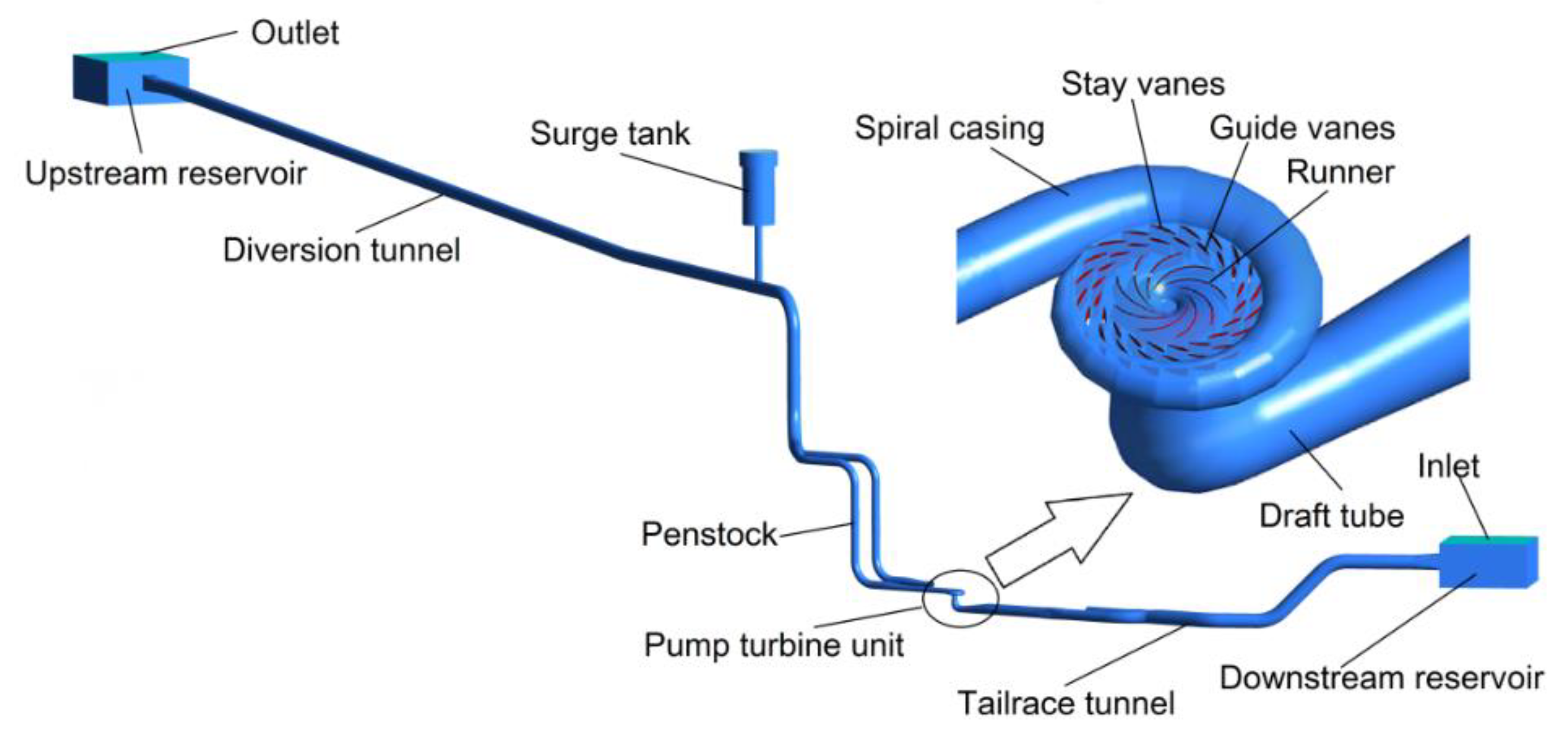

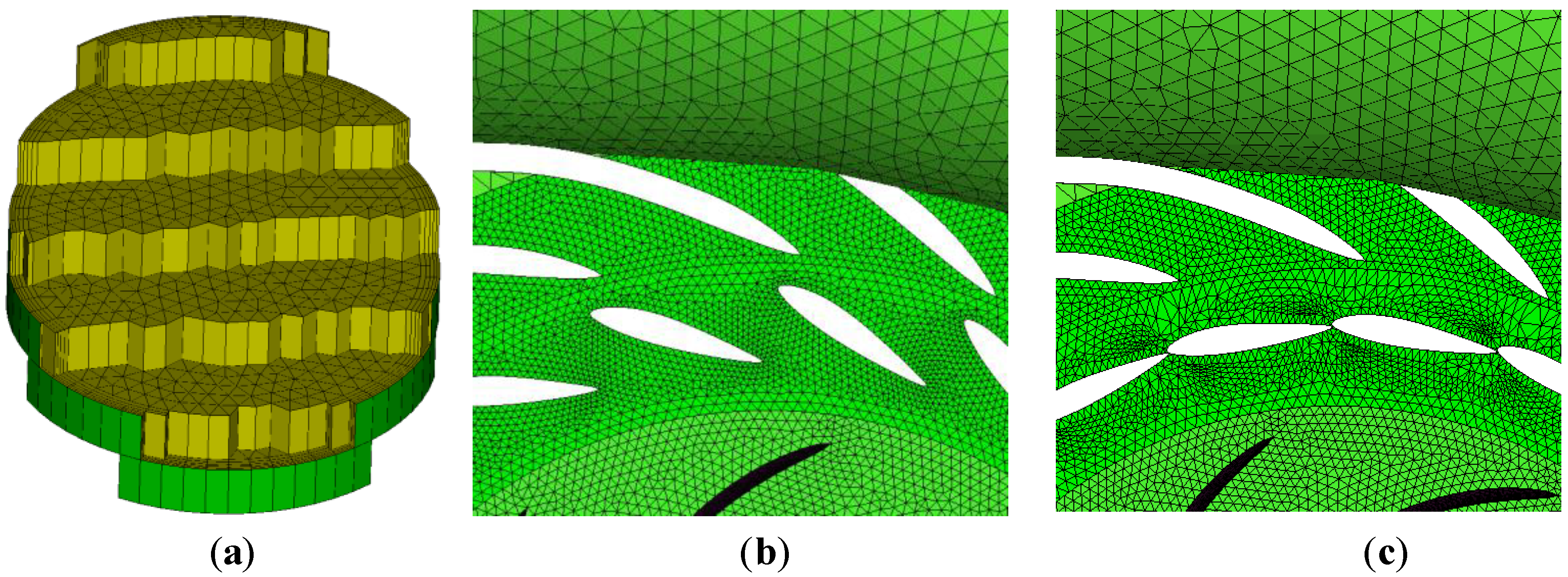
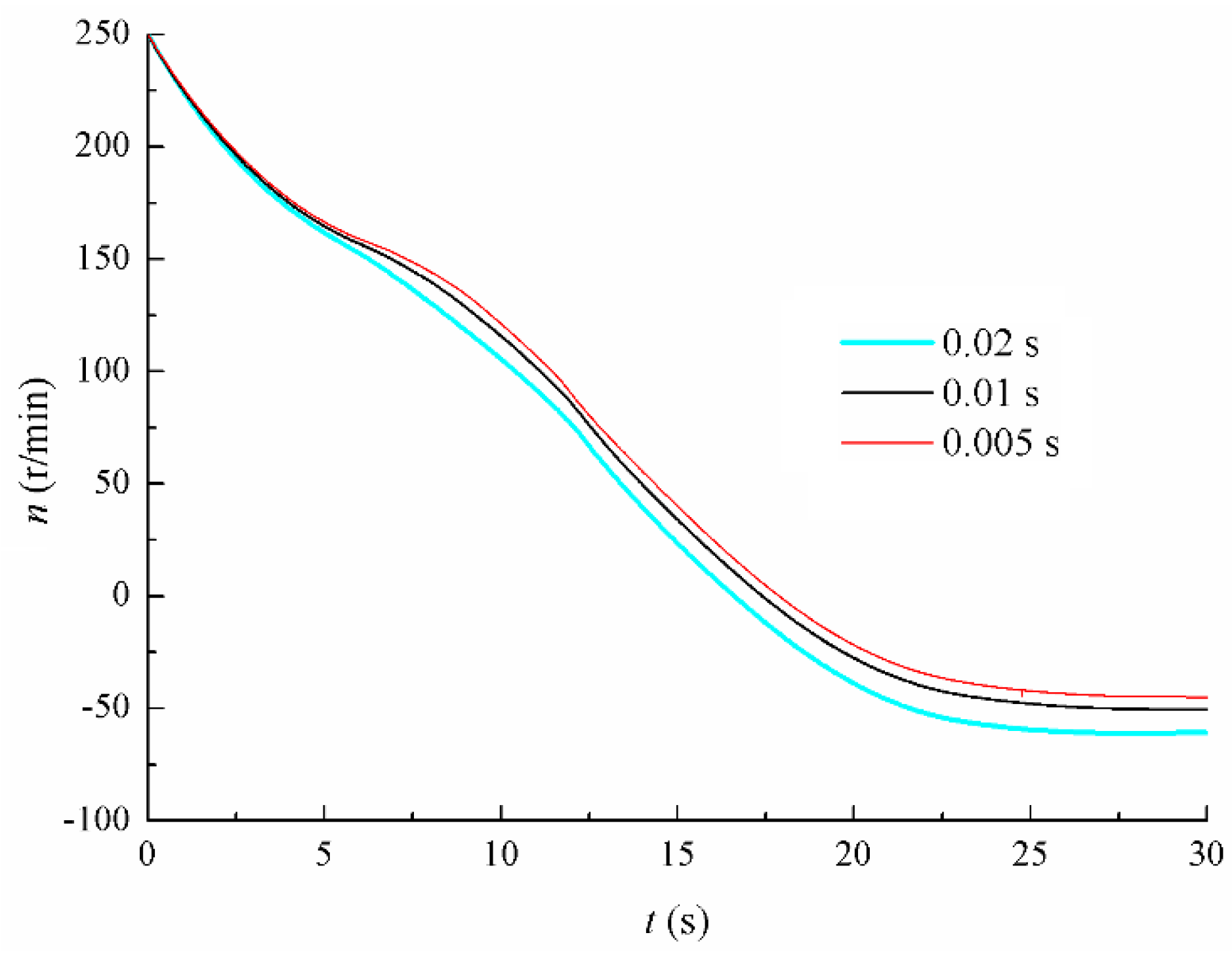
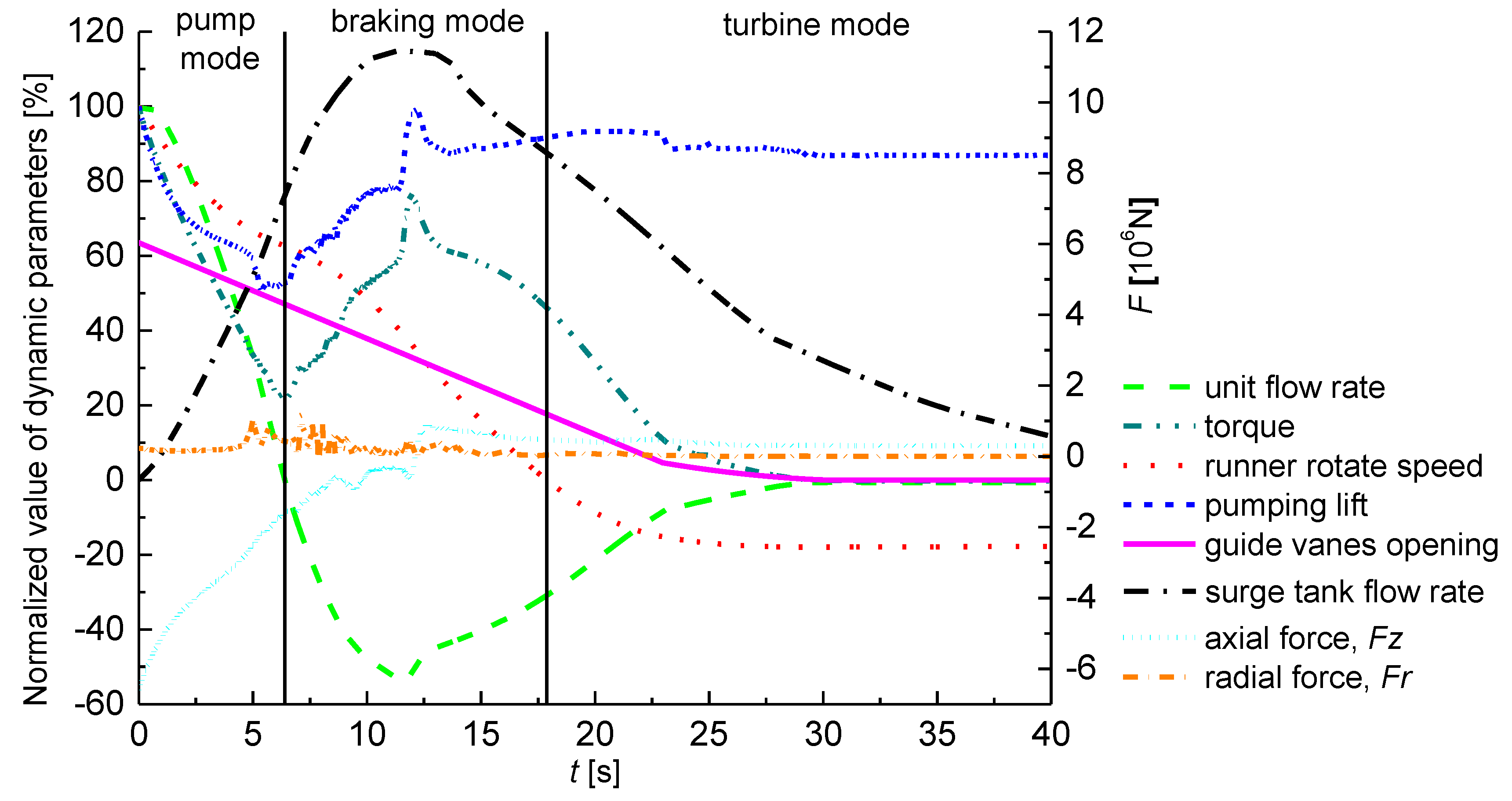
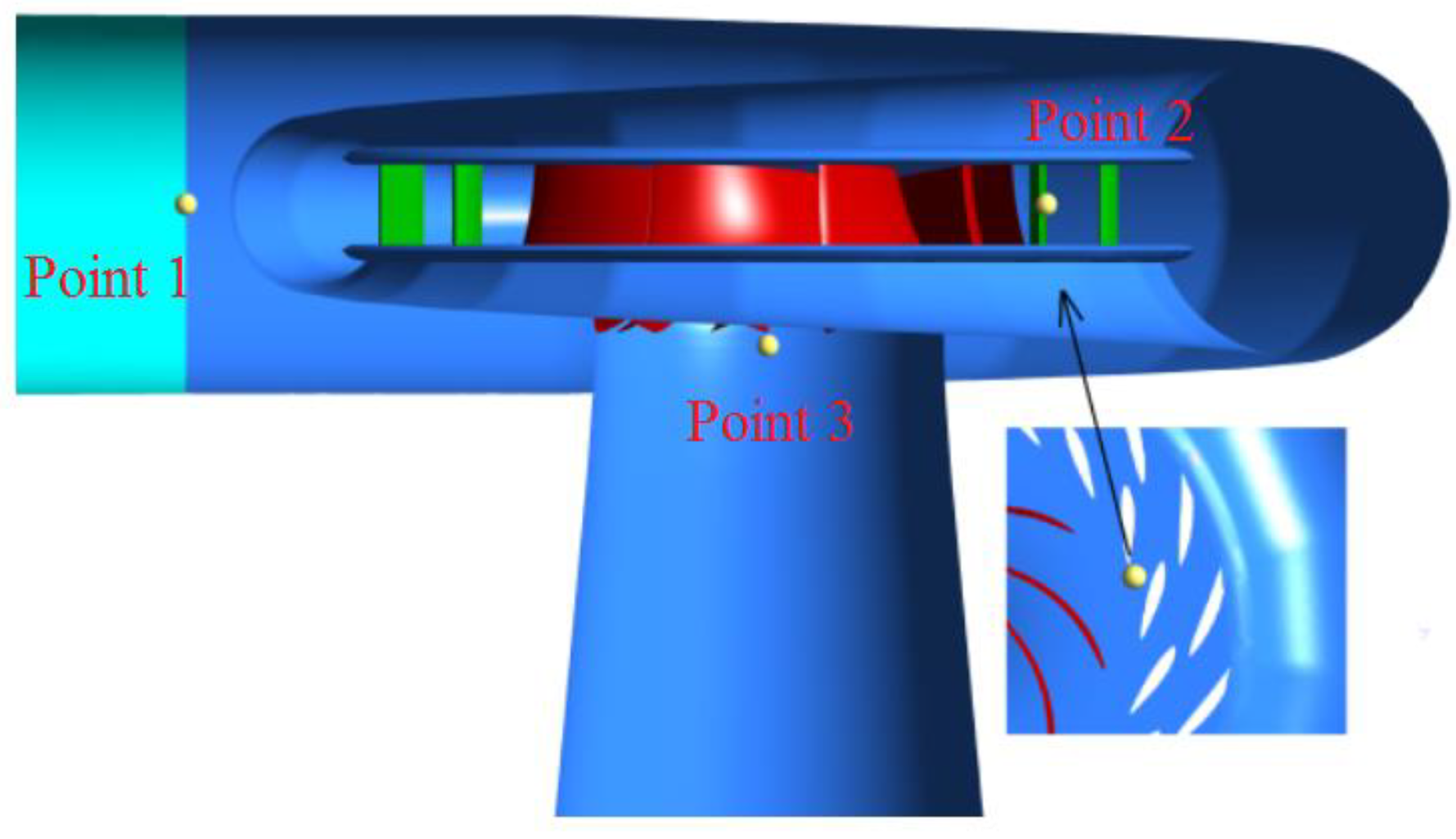

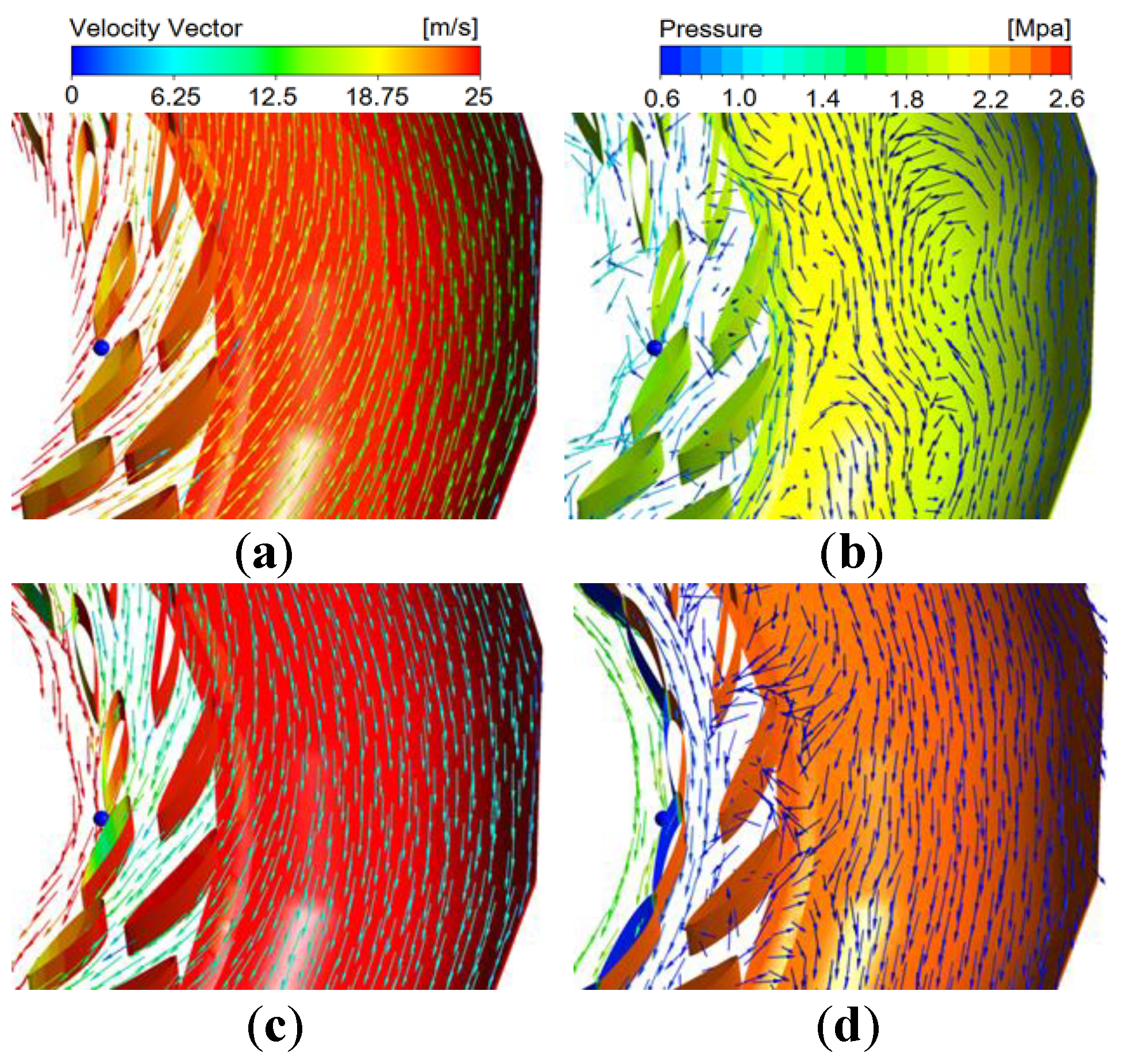
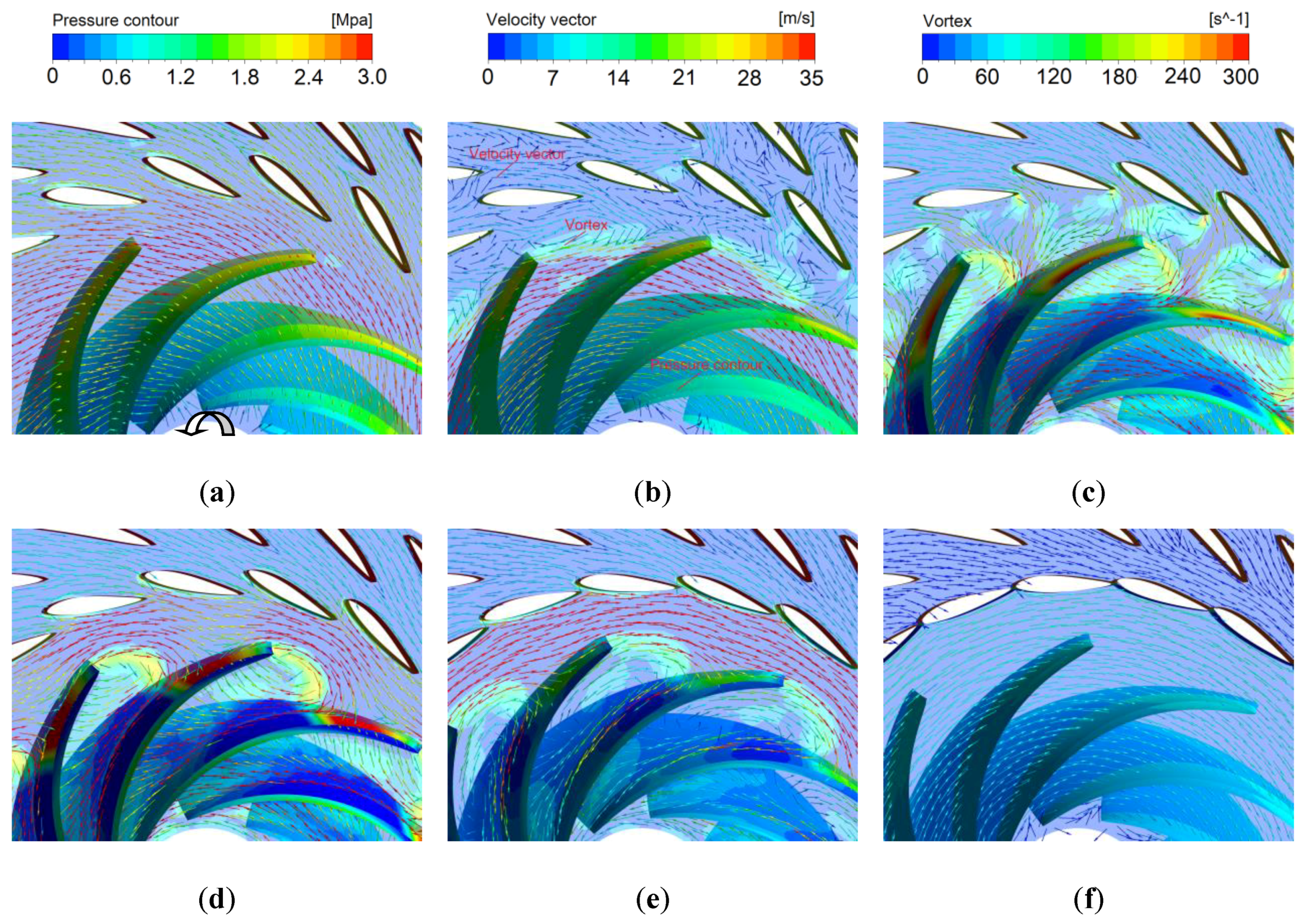

| Passage | Mesh Elements Type | Mesh Numbers |
|---|---|---|
| Upstream reservoir | Tet/Hybrid | 93,814 |
| Diversion system | Hex/Wedge | 480,516 |
| Surge tank | Hex/Wedge | 382,608 |
| Casing | Tet/Hybrid | 435,415 |
| Stay/guide vane | Tet/Hybrid | 795,432 |
| Runner | Tet/Hybrid | 714,785 |
| Draft tube | Tet/Hybrid | 560,718 |
| Tailrace system | Hex/Wedge | 410,845 |
| Downstream reservoir | Tet/Hybrid | 93,814 |
© 2018 by the authors. Licensee MDPI, Basel, Switzerland. This article is an open access article distributed under the terms and conditions of the Creative Commons Attribution (CC BY) license (http://creativecommons.org/licenses/by/4.0/).
Share and Cite
Zhou, D.; Chen, H.; Zhang, L. Investigation of Pumped Storage Hydropower Power-Off Transient Process Using 3D Numerical Simulation Based on SP-VOF Hybrid Model. Energies 2018, 11, 1020. https://doi.org/10.3390/en11041020
Zhou D, Chen H, Zhang L. Investigation of Pumped Storage Hydropower Power-Off Transient Process Using 3D Numerical Simulation Based on SP-VOF Hybrid Model. Energies. 2018; 11(4):1020. https://doi.org/10.3390/en11041020
Chicago/Turabian StyleZhou, Daqing, Huixiang Chen, and Languo Zhang. 2018. "Investigation of Pumped Storage Hydropower Power-Off Transient Process Using 3D Numerical Simulation Based on SP-VOF Hybrid Model" Energies 11, no. 4: 1020. https://doi.org/10.3390/en11041020




